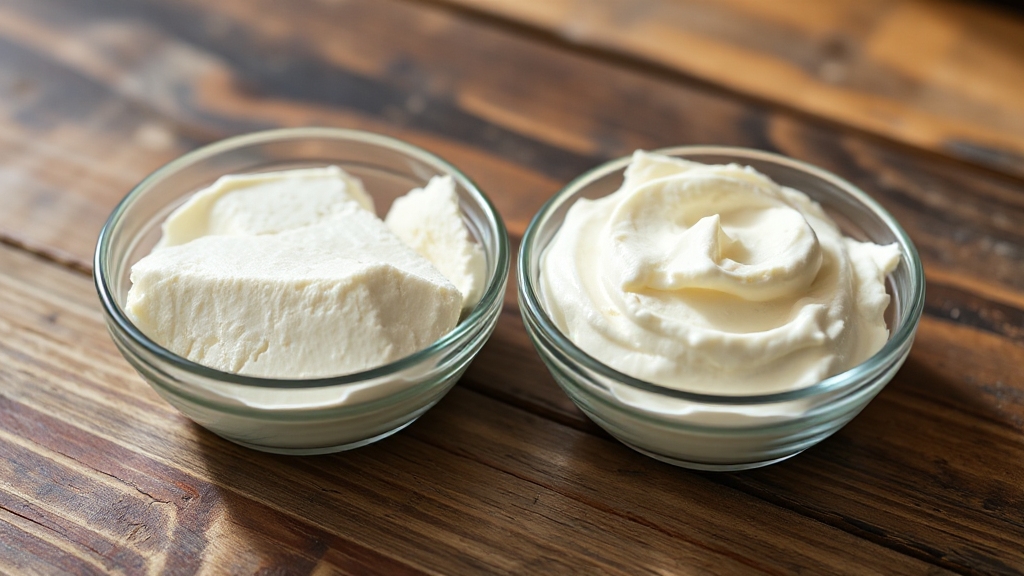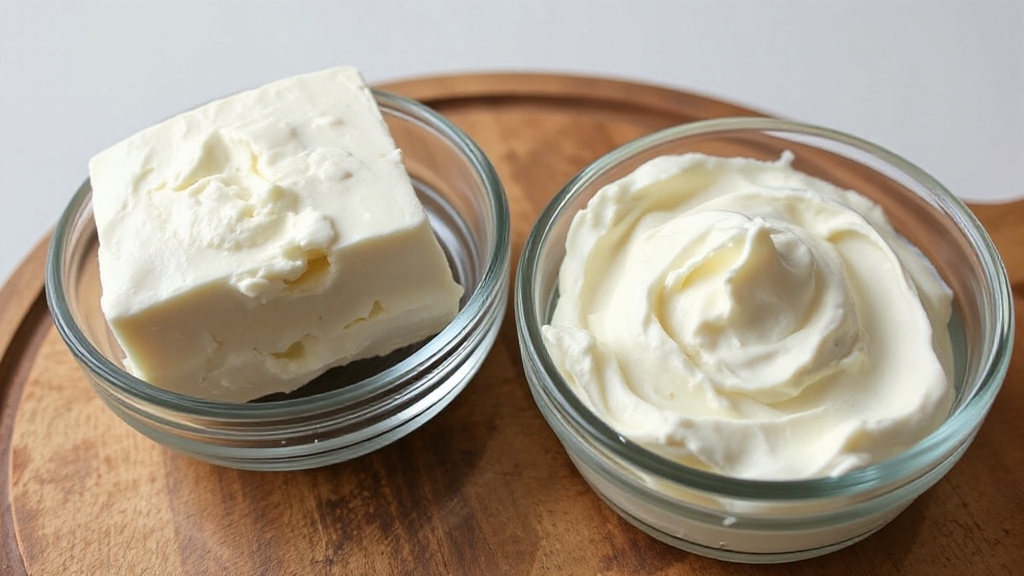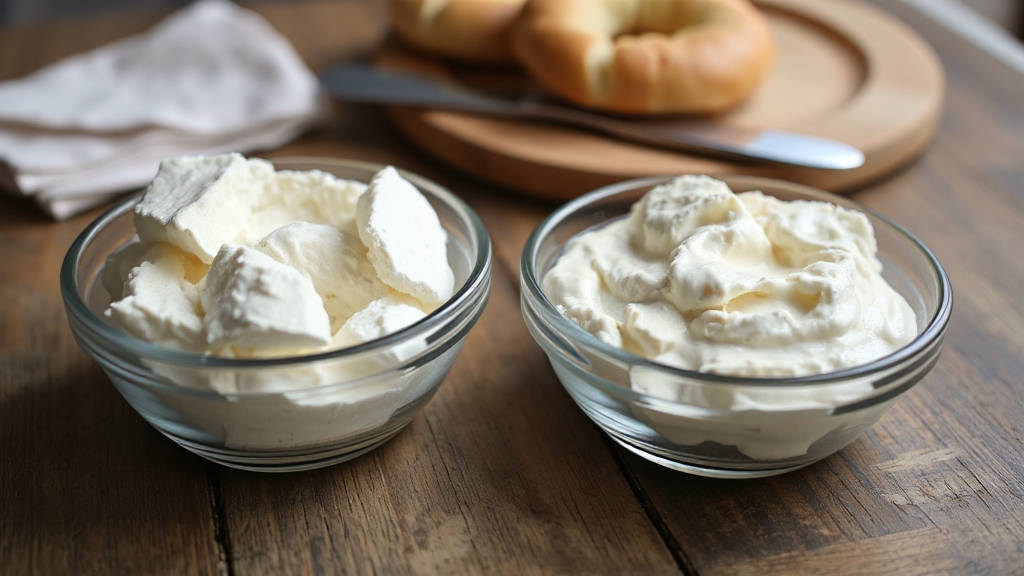Cream Cheese vs Cream Cheese Spread: Find the Perfect
You’ll find cream cheese is denser with at least 33% milkfat, fermented and strained for a firm, rich texture ideal for baking or thick spreads. Cream cheese spread has added stabilizers like guar and carob bean gums, making it softer, lower fat, and easier to spread.
Both require refrigeration but differ nutritionally and functionally. Understanding these distinctions helps you choose the right product for your culinary needs and dietary goals—explore how processing and ingredients shape their unique properties.
Key Takeaways
- Cream cheese is denser with at least 33% milkfat, while cream cheese spread has stabilizers and lower fat for easier spreading.
- Cream cheese offers a firmer, sometimes grainy texture; spreads are softer and maintain smoothness due to added gums.
- Both require refrigeration below 40°F, but cream cheese has a longer shelf life unopened compared to spreads.
- Nutritionally, cream cheese is higher in fat and calories, while spreads may have reduced fat and sodium with added proteins.
- Cream cheese suits baking and cooking; spreads are preferred for dips and smooth application on breads and crackers.
Definition and Composition Differences

Although cream cheese and cream cheese spread share core ingredients like milk, cream, salt, and cheese cultures, they differ particularly in composition and formulation.
Cream cheese is primarily fermented milk and cream with minimal additives. It is often packaged as an 8 oz refrigerated block, which helps maintain its freshness and quality. Its temperature range for storage is critical to preserving its texture and flavor.
Cream cheese spread often includes thickeners such as guar gum and additional proteins to enhance spreadability and shelf life. You’ll find that cream cheese undergoes fermentation followed by straining and blending to achieve its smoothness, relying on natural cultures.
In contrast, cream cheese spread is typically processed further, blending in stabilizers like guar gum, whey protein concentrate, or skim milk post-fermentation to maintain texture and extend shelf life.
These compositional differences impact nutritional content, with cream cheese generally having higher fat and calorie levels. Whereas spreads balance reduced fat with added stabilizers and preservatives for commercial viability.
Texture and Consistency Comparison
When evaluating cream cheese and cream cheese spread, their texture and consistency reveal significant differences driven by formulation and processing methods.
You’ll notice cream cheese has a higher yield stress and denser consistency due to its minimum 33% milk fat content. Precise measurement of ingredients using digital kitchen scales can greatly enhance consistency in cream cheese production.
In contrast, cream cheese spread incorporates stabilizers like carob bean gum, enhancing spreadability and providing a softer texture at room temperature. The production process involves coagulating milk with rennet to form curds, which influences the final texture.
- Cream cheese’s texture depends on fermentation temperature and homogenization pressure, affecting graininess and smoothness.
- Cream cheese spread exhibits higher apparent yield strain, making it easier to spread without breaking.
- Temperature fluctuations influence both products’ consistency, with warmer conditions softening the texture.
- Proper refrigeration is essential to maintain the emulsion stability and prevent texture degradation in both variants.
Culinary Uses and Applications

Since cream cheese and cream cheese spread differ in texture and consistency, they also serve distinct culinary functions that leverage their unique properties.
Cream cheese’s dense, firm texture suits baking, frostings, and dense fillings, while cream cheese spread’s softer consistency excels in dips and easy spreading. Additionally, cream cheese can be incorporated into savory recipes such as pasta sauces and soups to enhance richness and flavor due to its rich, creamy texture.
Both products offer versatility, but understanding their ingredient quality and shelf life can impact your final dish, similar to how ingredient quality affects bread mixes.
| Application | Cream Cheese | Cream Cheese Spread |
|---|---|---|
| Baking | Moistens cakes, scones | Rarely used due to soft texture |
| Frostings | Ideal for thick frostings | Less stable, often avoided |
| Spreads | Firmer, requires softening | Ready-to-use, smooth application |
| Dips | Rich, adds density | Easily blends, pourable consistency |
| Sauces & Soups | Adds creaminess, thickens | Less common, may separate |
Storage Requirements and Shelf Life
Understanding the different culinary roles of cream cheese and cream cheese spread highlights the need to preserve their unique qualities through proper storage. Store both products below 40°F (4°C) in airtight containers to prevent moisture and contaminants, placing them in the refrigerator’s coldest section.
Keep cream cheese and spreads fresh by storing them below 40°F in airtight containers in the fridge’s coldest area.
Avoid freezing, as it degrades texture and quality. Note that unopened cream cheese lasts 1–2 months past its “best by” date, while opened products remain fresh for 1–2 weeks. Similarly, cream cheese spreads share comparable shelf lives influenced by packaging and ingredients.
- Use airtight containers to minimize air and moisture exposure
- Refrigerate promptly after up to one hour at room temperature
- Avoid temperature fluctuations and high humidity
- Monitor regularly for mold or off odors to ensure safety
Proper storage encourages a healthy microbial environment, similar to how maintaining microbial diversity in sourdough starters enhances their quality and longevity.
Nutritional Profile Variations

You’ll notice cream cheese typically contains higher fat and calorie levels compared to cream cheese spread. Cream cheese spread often has reduced fat and salt content. These differences substantially affect their nutritional impact and suitability for various diets. Additionally, cream cheese is made from cow’s milk, contributing to its rich and authentic flavor.
For those seeking lower fat options, using Greek yogurt as an alternative frosting base can offer a creamy texture with less fat and added protein, making it a popular choice in cream cheese frosting alternatives. Understanding these variations helps you choose healthier spread alternatives based on your dietary goals.
Fat Content Differences
Although cream cheese and cream cheese spreads share similar dairy origins, their fat content varies considerably, directly influencing their nutritional profiles. Cream cheese typically contains over 30% fat, resulting in a denser, richer product. The fat content differences also affect baking and cooking applications, where precise measurements are important for consistent results.
In contrast, cream cheese spreads often incorporate plant-based fats or less milk fat, reducing overall fat content and altering texture and nutrient density. This variation affects not only mouthfeel but also the distribution of fat-soluble vitamins and calories.
Cream cheese is made by thickening milk cream using lactic acid bacteria, which contributes to its distinctive taste and texture.
When selecting between the two, consider your dietary goals and fat intake requirements.
- Cream cheese’s higher fat level supports a creamy, dense texture ideal for cooking.
- Spreads offer lighter, smoother consistency with reduced fat.
- Plant-based ingredients in spreads lower fat and modify nutritional value.
- Fat content differences impact nutrient absorption and health considerations.
Calorie and Salt Levels
Fat content naturally influences the calorie density of cream cheese and its spreads, but examining their calorie and salt levels reveals additional nutritional distinctions.
Cream cheese typically contains around 100 calories per 2-tablespoon serving, with sodium levels near 120-130 mg. It also provides small amounts of vitamins A and calcium, contributing to its nutrient profile per serving. Understanding the impact of ingredients like buttermilk and oils can help tailor cream cheese alternatives with specific nutritional goals.
Cream cheese spreads, being calorie-dense, contain roughly 708 calories per cup, but variations exist across brands due to ingredient differences. Sodium content also fluctuates, influenced by added salt for flavor enhancement, which is important to consider when managing sodium intake.
While cream cheese has moderate protein (2-3g per serving) and low carbohydrates, its high saturated fat content increases calorie density.
You should monitor sodium intake if you have dietary restrictions, as excessive sodium poses health risks.
Healthier Spread Alternatives
When selecting cream cheese spreads, considering nutritional profile variations can guide you toward healthier choices. You’ll want to focus on factors like fat type, caloric density, and micronutrient content to optimize your selection.
For instance, whipped cream cheese offers lower fat and calories compared to traditional versions, making it suitable for weight management.
Additionally, some spreads incorporate higher monounsaturated fats, which support heart health better than saturated fats found in regular cream cheese. The inclusion of lactic acid bacteria in these spreads may provide probiotic benefits, potentially supporting immune health.
- Choose whipped or Neufchâtel cheese spreads for reduced fat and calories.
- Monitor saturated versus monounsaturated fat ratios to minimize cardiovascular risk.
- Consider vitamin A and riboflavin contributions for added nutritional benefit.
- Note the low glycemic index and acidity levels to maintain blood sugar stability and dietary pH balance.
Manufacturing Processes and Ingredients
You’ll notice that cream cheese and cream cheese spread differ notably in their ingredient composition, with cream cheese relying on whole milk and heavy cream, while spreads incorporate thickeners and preservatives.
Their production techniques reflect these differences, as cream cheese undergoes fermentation and curd separation, whereas spreads focus on blending and moisture control for consistency.
During cream cheese production, the milk is heated to around 86°F and acidified with cultures before coagulation, which is a crucial step in developing the cheese’s texture and flavor.
Ripen Milk These processes share similarities with fermentation techniques used in sourdough starter preparation, where temperature and acidity play key roles. Understanding these processes helps clarify why their textures and shelf lives vary.
Ingredient Differences
Although both cream cheese and cream cheese spread share milk and cream as primary ingredients, their manufacturing processes and additive profiles diverge greatly to achieve distinct textures and functionalities.
You’ll notice that cream cheese adheres to strict regulations, requiring at least 33% milkfat and minimal additives, resulting in a dense, tangier product.
In contrast, cream cheese spread incorporates stabilizers and preservatives to enhance spreadability and shelf life, often with lower fat content due to whipping. This variation in fat and moisture content is similar to how different ingredients affect sourdough starter readiness.
Key ingredient differences include:
- Stabilizers in spreads prevent separation and improve texture.
- Brick cream cheese contains fewer additives, emphasizing dairy flavor.
- Spreadable versions may include air, reducing density.
- Fat and moisture contents vary, affecting firmness and mouthfeel.
Because spreadable cream cheese is typically whipped and aerated, it has a lighter texture and reduced volume compared to brick cream cheese.
Production Techniques
Since production techniques directly impact texture and consistency, understanding the manufacturing processes behind cream cheese and cream cheese spread is essential.
Cream cheese typically involves fermenting cream with milk at a precise fat ratio, followed by acid coagulation using agents like lemon juice or vinegar. Heat treatment precedes curdling to separate curds and whey efficiently.
Heavy whipping cream is essential for achieving the classic cream cheese thickness and rich, creamy texture. The use of precise temperature control during fermentation ensures optimal consistency and flavor development.
Industrial production relies on equipment such as Silverson mixers and jacketed vessels to maintain temperature and perform high shear mixing, ensuring uniform emulsion formation.
Cream cheese spread incorporates additional ingredients, thickeners, and emulsifiers like lecithin, blended with other dairy products to optimize spreadability. Controlled hydration processes guarantee consistent texture.
Compared to homemade methods with simpler tools, industrial techniques prioritize efficiency, hygiene, and quality control to maintain viscosity, shelf life, and consumer satisfaction.
Popular Brands and Consumer Preferences
When choosing between cream cheese and cream cheese spread, you’ll find that popular brands cater to distinct preferences based on texture, fat content, and added ingredients. Philadelphia offers a classic, reliable taste in both block and spreadable forms, while Tillamook provides a higher fat, creamier block option.
Organic Valley emphasizes organic sourcing but may have texture inconsistencies. Nancy’s targets health-conscious consumers with probiotic spreads, and 365 by Whole Foods excels in smoothness and affordability. Blocks generally have denser texture and require more effort to transfer, making them ideal for certain culinary uses.
- Block cream cheese suits baking due to firmness; spreads favor quick, easy applications.
- Spreads often contain stabilizers like xanthan gum for improved spreadability.
- Fat content varies: blocks generally contain more fat than spreads.
- Probiotic and organic options reflect growing health and sustainability trends in consumer preferences.
Frequently Asked Questions
Can Cream Cheese Spread Be Frozen Without Texture Loss?
You can freeze cream cheese spread, but expect some texture loss due to water and fat separation. Freezing disrupts the emulsion, causing graininess and crumbliness after thawing.
Its lower fat content and added emulsifiers influence this effect but don’t prevent it entirely. To minimize texture issues, use frozen spread primarily in cooking or baking.
Whisking and warming after thawing can help partially restore smoothness for direct use.
Are There Vegan Alternatives for Cream Cheese and Spreads?
You’ll find vegan cream cheese alternatives so good, they could fool a dairy scientist. Brands like Wayfare, Trader Joe’s, and Kite Hill use ingredients such as coconut, oats, and sunflower seeds to closely mimic traditional cream cheese’s texture and flavor.
These options cater to allergies and dietary restrictions, offering soy-free, gluten-free, and organic choices. You can use them just like dairy cream cheese, from spreads to dips, without compromising nutrition or taste.
How Do Allergies Differ Between Cream Cheese and Spreads?
You should note that both products contain milk allergens, posing risks if you’re dairy-sensitive. However, cream cheese spreads may have higher cross-contamination risks since they’re often made in facilities handling nuts or fish.
Shared processing equipment increases allergen transfer potential, despite strict cleaning protocols. Always check allergen testing reports and ingredient labels carefully to avoid unexpected exposure, especially if you have multiple food allergies or sensitivities.
Which Product Has a Lower Environmental Impact During Production?
Imagine each product as a footprint in the earth’s soil. You’ll find that spreads often have a lower environmental impact, especially when they incorporate plant-based ingredients, reducing reliance on dairy’s high emissions and water use.
Additionally, spreads can benefit from more sustainable packaging and efficient processing. However, the exact impact varies with production specifics, so you should assess raw material sourcing, energy consumption, and supply chain practices to determine which truly minimizes environmental harm.
Can Cream Cheese Spread Be Used in Cooking Like Brick Cream Cheese?
You can use cream cheese spread in cooking, but it requires adjustments due to its lighter texture and stabilizers. Its lower density affects volume measurements, potentially altering the dish’s consistency and flavor.
For recipes needing richness or firm structure, like baking or fondue, brick cream cheese performs better. However, for spreads or dips, cream cheese spread works efficiently.
Experiment with quantities to achieve desired results when substituting.
Spread or Slice—Tailor Your Choice to Your Needs
Steering the differences between cream cheese and cream cheese spread is like choosing the right tool for a precise task. You’ll find cream cheese denser and richer, ideal for baking and firm textures, while spreads offer smoother consistency, perfect for easy spreading.
Understanding their composition, uses, and storage helps you select exactly what your recipe or palate demands. Armed with this knowledge, you can confidently optimize flavor and texture in any culinary application.







